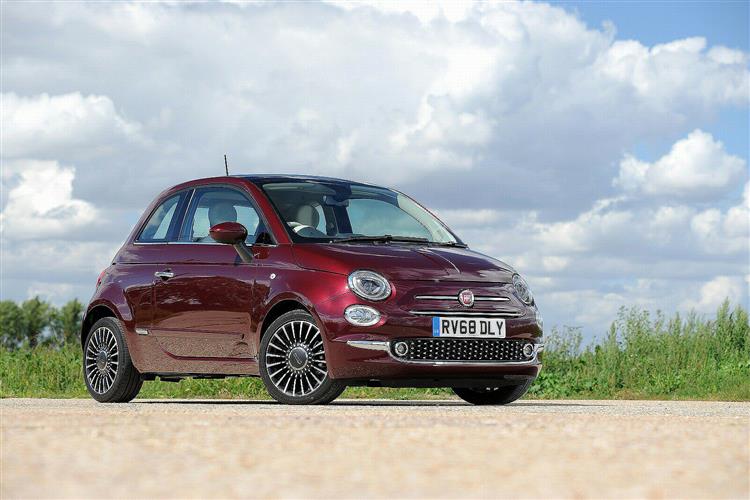GOING FOR A SMARTER ITALIAN (some text hidden) --NONE--
By Jonathan Crouch
Introductionword count: 86
Fiat's cheeky little 500 is a stylish city car that remained as appealing as ever in this rejuvenated post-2015 guise. The car wasn't fundamentally changed as part of this mid-term facelift - but then loyal buyers didn't really want it to be. These people will like the smarter look, the extra media options and the more individual feel that came with this update. You can tell that Fiat knows its market. If you're looking for a used 500, it's worth stretching to this rejuvenated post-2015-era version.
Modelsword count: 17
3dr citycar (0.9, 1.2 & 1.4 T-Jet petrol / 1.3 MultiJet diesel [Pop, Lounge, S, Mirror, Abarth])
Historyword count: 377
If ever a car has built its brand, it's this one, Fiat's 500. In fact, it's done so several times. First at its original launch back in 1957. And more recently with this modern era version, first launched in 2007 and significantly improved in mid-2015 to create the refreshed version we're going to look at here. You could argue that the reason why this car was created at all lies with the existence of its closest rival, BMW's MINI. When that car was re-launched for the modern era at the turn of the century, Fiat realised it could do the same thing by reinventing its classic 1950s Nuova Cinquecento model. So the Italian brand set to work, creating a new car that drew upon the fashionable cues of the old one and launching it just in time to take on the second generation MINI model. Shortly after the 500's original launch, we got the option of an open-topped 500C body style and frantic Abarth-branded hot hatch versions. Then in 2010, a clever 85bhp two cylinder TwinAir petrol engine was added to the range for extra pep and a little more economy, with a pokier 105bhp version of this unit added to the range in 2014. There was a 1.3-litre diesel engine too. But more work was needed. By 2015, this Fiat was facing tougher competition, not only from the MK3 version of the MINI Hatch but also from other style-orientated small cars like the Vauxhall ADAM, the Citroen-derived DS3 and new generation versions of smart's fortwo and forfour models. Hence the thorough update that created the revised facelifted version of this car we're going to look at here. The look didn't change much as part of this facelift - it didn't need to. Looks were the main reason why prior to 2015, over 1.5 million people had bought themselves this car. Minor tweaks though, brought the styling into line with other larger models in the wider 500 range, plus there was a little more efficiency, more scope for personalisation and wider availability of the Fiat Group's Uconnect infotainment technology. The 500 sold in this form until 2020 when mild hybrid engineering was introduced. It's the 2015-2020-era model though, that we look at here as a used buy.
What You Getword count: 377
We'd understand if you concluded that this facelifted post-2015-era Fiat 500 looks pretty much the same as the earlier version. Nevertheless, Fiat insisted that no fewer than 1,800 changes were made in improving it. None of these altered the dinky external dimensions, so at just 3.5m long, 1.6m wide and 1.5m high, this Fiat can easily fit into spaces that even a MINI would have to avoid. If you choose the 500C variant rather than the fixed-top model, you get what amounts to a full-length canvas sunroof which electrically retracts into a concertinaed bundle just above the boot. Most of the exterior styling tweaks that were made here can be found at the front. As part of the update, the main round headlights adopted clever polyellptical modules for improved night time vision and integrated dipped-beam headlamps and turn signals. The lower lights just below deal with the main beam and LED daytime running light functions and adopted the same circular profile so as to graphically reproduce the zeros of the '500' name. Inside, delicious details are everywhere, the coloured fascia panels featuring iconic '500' badging and colour-matched against the bodywork. The key change to this improved model was reserved for plusher variants, a 5-inch 'Uconnect LIVE' infotainment display screen mounted high on the dashboard, right in your line of sight. This system, which was optional on lower-spec models, allows Bluetooth hands-free calling, music streaming, voice recognition and an SMS reader that will read text messages to you. As for the rear seat, well, given that the external dimensions of this car are so short, you won't be expecting to find much room there - and there isn't. Larger adults will find their heads brushing the roof and will need to make full use of the elbow cut-outs indented into the side panels. Most though, will find the space provided just about sufficient for two people on short to medium journeys - and it'll probably be fine for kids. Out back, the boot has a high lip and a narrow opening and remains one of the more compact offerings in the segment. Once you get your stuff in though, the 185-litre space it provides is no smaller than an ordinary mainstream citycar like Toyota's Aygo would give you.
To see the full road test text contact us on 0330 0020 227
Pictures (high res disabled)

.jpg)
|
.jpg)
|
.jpg)
| |||
.jpg)
|
.jpg)
|
.jpg)
| |||
.jpg)
|

|
Scoring (subset of scores)
Category: Small Runabouts
| Performance | |
| Handling | |
| Comfort | |
| Space | |
| Styling, Build, Value, Equipment, Depreciation, Handling, Insurance and Total scores are available with our full data feed. | |



